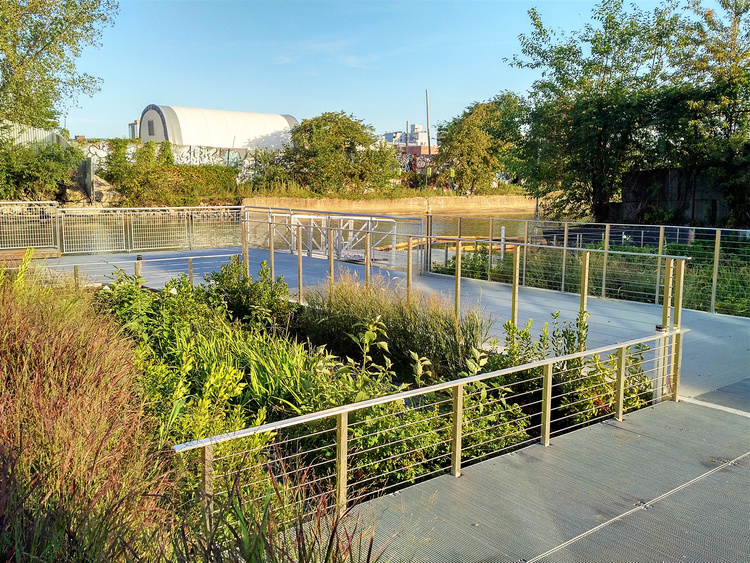When you first hear the term “sponge park” you envision a children’s park made entirely of giant sponges. You may even think of the cartoon character Sponge Bob as the main attraction of a water park. You would be absolutely wrong! Consider the concept of a household sponge. It holds water and has the ability to be super absorbent. A sponge park aims to clean up areas by soaking up pollutants and removing them from the region they are contaminating. The most popular sponge park in our area is located in the Gowanus Canal in Brooklyn, New York. Sponge Parks
Dutch farmers settled in Gowanus Bay in 1636. While the ponds were part of the appeal to the settlers they drained them in the 1860s and built the Gowanus Canal. The area became an industrial center. Coal manufacturing and sewage outflows during the 19th century have caused the canal to become polluted. It is now mostly bordered by industrial buildings surrounded by residential neighborhoods. Over decades, the industry has polluted the soil and canal bed, accumulating dangerous industrial toxins in the water.
At only 2,100 square feet, the Gowanus Canal Sponge Park is stopping thousands of gallons of polluted water from entering the canal each year. It was designed in 2016 by DLAND studio, an interdisciplinary design firm located in Brooklyn, New York. This modular pilot project, located at the end of Second Street, is capable of managing 2,000,000 gallons of runoff per year.
The 1758 acre physiographic and jurisdictional watershed boundary contributes water to the canal from Brooklyn’s Park Slope, Carroll Gardens, and Boerum Hill neighborhoods. In heavy rain, stormwater combines with sewage and drains directly into the canal. The Sponge Park is designed to absorb and manage excess surface water runoff. This will make the water’s edge a healthier place for supporting active public engagement within the canal ecosystem.
On the surface, it looks just like a park with lush gardens filled with paths for pedestrian foot traffic. It took eight years to plan and eight weeks to build. In total, the project cost $1.5 million. The system will filter stormwater that picks up street and sewage pollutants before running off into the waterways. This pollution causes the water to not meet safety standards for fishing, swimming, and wildlife habitats. Through the use of flood-tolerant plants and sand beds, the water is now filtered through the “sponge” and pollutants are held behind as to not contaminate the waters.
Even with its highly polluted walls, the Gowanus Canal still evokes inherent natural beauty. The design of the Sponge Park aims to enhance and showcase this beauty by creating an urban waterfront park along its banks that uses the landscape to clean the water. With all of the changes to the area, Gowanus is seeing new life. The area is approved for mid-level manufacturing, and more restaurants and bars are coming to the area. Sponge Park is doing its job and is working to clean the area’s pollution. A thought about the project by the founder of DLAND studio:
—I didn’t want to go into a community and tell them that I’m putting a wetland in their backyard … But everyone understands what a sponge does, even if they don’t understand green infrastructure or phytoremediation. “— Susannah C. Drake founder of DLANDstudio
New York’s combined sewer system regularly discharges right into the Gowanus canal, adding further pollution. Access to the water’s edge is limited to publicly-owned streets that end at the canal. Despite these unfavorable conditions, increased demand for real estate in Brooklyn has spurred some private development projects that are opening up the edge within their boundaries. The city realized the need for a plan for the development of publicly accessible and environmentally open space for the Gowanus, thus DLANDstudio created the Sponge Park Masterplan.
The Masterplan consists of a strategy of urban stitching, connecting the public and private lands adjacent to the canal to create a continuous esplanade complete with recreational spaces running the length of the canal. The already existing public street ends would serve as entry points providing access to the esplanade and the water. These parks will provide community-oriented programs such as dog runs, community gardens, public exhibition spaces, and temporary markets. There have been requests by the community for boat launches or ladders to be located at every street, creating a further connection between the water and the land.
The Sponge Park has many unique features; it is a working landscape and has the ability to improve the environment of the canal over time. It will accomplish this while simultaneously supporting public engagement with the canal and its ecosystem. This idea can be implemented in sites all across the country. It is especially applicable to mature cities whose infrastructure is being taxed by age and growth. It is ideal in areas where industrial development has left behind inhospitable and toxic landscapes.
This environmental urbanism is a synthetic idea that can be implemented in related sites across the country. It is applicable to mature cities whose infrastructure is taxed by age and growth as well as in areas where industrial development has left behind inhospitable toxic landscapes. The concept is simple yet brilliant. Will Sponge Parks begin to pop up all over the world? Time will tell and the ecosystems will ultimately benefit which is surely a win for everyone!


